The Rise of Cable TV – A History of TV Entertainment

Table of Contents
The invention of the television is arguably one of the most significant technological advancements of the 20th century and perhaps of all time. The ability to transmit video signals across large distances has opened so many doors, bringing entertainment, news, face-to-face communication, and much more into homes across the country.
However, the ubiquity of television that we now see today was not always the case. Connecting people to this new technology took time and a considerable amount of effort and investment. All of this led to the birth of a brand new industry: cable television.
Nowadays, cable TV, although quite common, is considered a luxury – it’s television we choose to pay for because we want access to more and better programming. Yet this was not always the case. In fact, cable TV’s story begins with the quest to connect more and more people to basic programming. After all that cable TV has done, some say we’re entering its final phase, with streaming and other options set to finally banish it to the annals of history. Whether or not this is true remains to be seen, but when we look at the history of TV entertainment, we see an exciting story that has played a crucial role in defining our modern age.
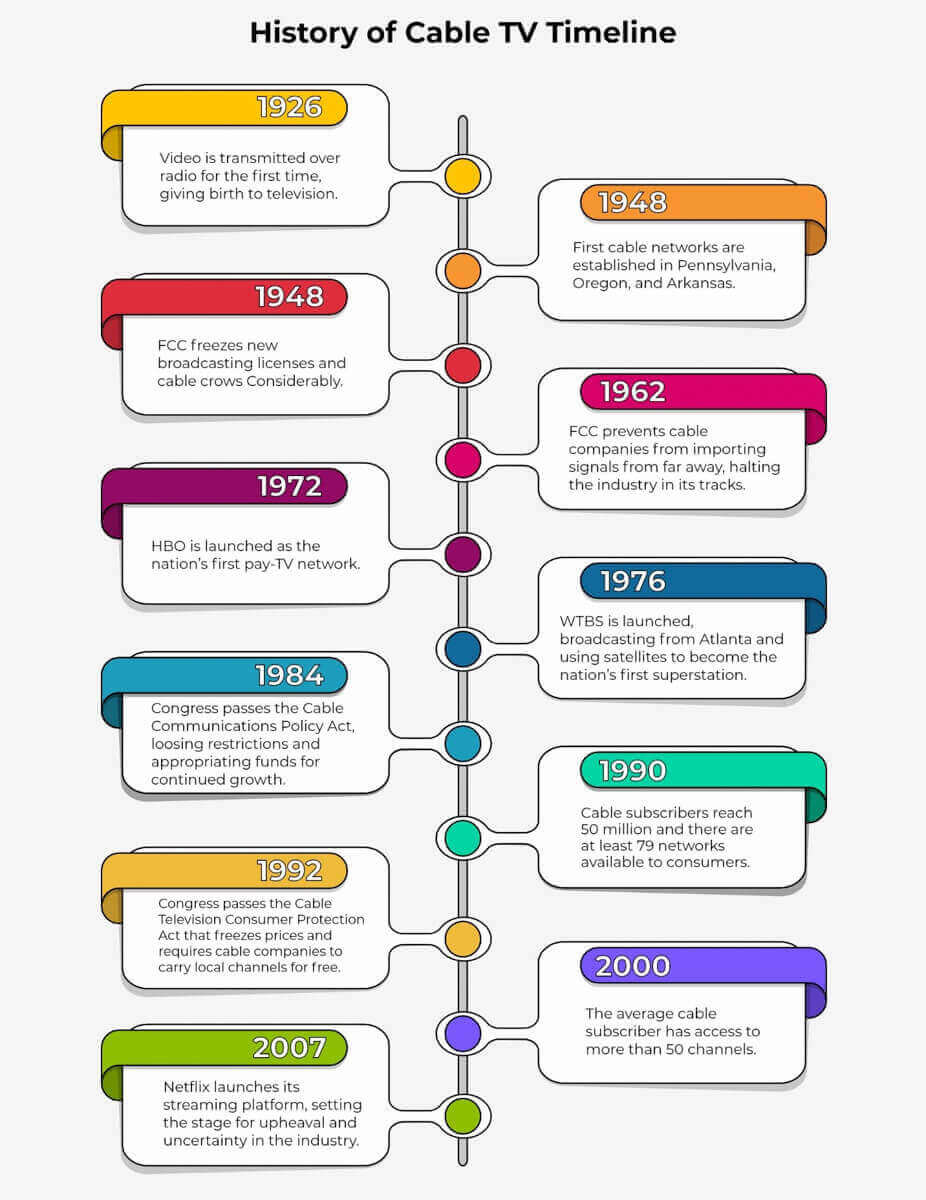
The Birth and Rise of Television
While we want to focus mainly on the rise of cable television, that story cannot be told if we don’t first discuss television’s birth in general. Pinpointing the exact moment when television began is difficult. This is because television had been in the works starting as far back as the late 19th century. However, most of these developments were in the field of “mechanical television,” which, while important to the story, does not look much like how we understand television today.
One date of particular significance was January 26, 1926. On this date, Scottish inventor John Logie Baird transmitted images of a ventriloquist’s dummy’s face using radio signals. This is generally considered the first-ever transmission of video, or, in other words, the birth of television as we know it today.
From that point on, the technology behind television became more advanced and accurate. Still, in its primitive state, it struggled to compete with radio, which had been the preferred medium for communication and entertainment for most of the 20th century. However, by the 1940s, television was making inroads into more and more American homes, growing in popularity and triggering a response from the entertainment industry.
By 1948, all four of the major broad networks in the US – CBS, ABC, NBC, and the DuMont Television network, which only lasted until 1955 – had full schedules for the 8 pm to 11 pm time slot that soon became known as “prime time.” One such show was The Texaco Star Theatre, which starred comedian Milton Berle. The show became the first hit in the history of television and helped spur the television industry’s growth. In fact, in 1948, before the show hit the air, just 2 percent of American homes had televisions, but by 1955, when the show went off the air, TVs were in more than 70 percent of homes across the country.
Of course, this doesn’t mean Berle was single-handedly responsible for the growth in TV, but it shows that the increase in available programming, along with its popularity, helped spur the medium into the mainstream.
The Birth of Cable
While pinpointing the moment television began can be tricky, it’s easy to find out when cable first burst onto the scene. Interestingly, while cable television has generally been viewed as a luxury version of TV, in the beginning, it was anything but. Instead, it was a practical way for those who could not reach broadcast signals to access the programming distributed from major cities.
In the early days of television, transmitting local broadcast signals were done via air. Those who weren’t close enough to the broadcast station or lived in mountainous areas where the signals would be disrupted could not access the signals and were left without television. The response to this was to build large antenna towers that could rise up over the mountains, get the signal, and then transmit that signal through hard wires – also known as cables. This meant homes previously left in the dark could connect.
These “community antennas" – as they became known – were first constructed in 1948 in Arkansas, Oregon, and Pennsylvania, bringing cable television to the world for the first time and launching a new era in technological and entertainment history.
The FCC Freezes All New Broadcasting Stations
The construction of these first cable networks in 1948 took place at perhaps the most opportune time possible. Due to the rapid growth in television’s popularity, new broadcast channels were popping up all over the United States. As this happened, the airspace got crowded, and in many areas, it became difficult for end-users to receive a clear signal because of all the interference between cable systems.
In response to this, the Federal Communications Commission (FCC) put a freeze on cable operators from creating new broadcasting stations in the United States. This was a good move as it helped them sort out the many existing cable channels, streamline the different frequencies, and improve overall service. Nevertheless, it was terrible news for those living in areas unable to tune into the existing basic cable television services that were already existing.
These individuals living outside of over-the-air service areas could still get television if they got access to cable. So the demand for this service grew considerably after the FCC freeze. By 1952, there were more than cable subscribers 14,000 across the country.
This number may not seem like much, but it’s essential to keep in mind that at the time, this was a brand new technology, and accessing it required a considerable investment in infrastructure (building the antenna, running cables, connecting homes, etc.). That so many people signed up in these first four years speaks to cable television’s growing popularity in mid-20th century America.
This trend continued throughout the 1950s as television grew in popularity, and people became more and more interested in accessing content broadcast from far away. By 1962, just fourteen years after the first cable TV setup was established, there were around 850,000 cable TV subscribers in the United States, representing an increase of more than 6,000 percent in less than two decades.
A big reason for this growth was the investment by major corporations such as Westinghouse and Cox. Cable was also an appealing product because it allowed people to access more programs by importing signals from networks that were far away.
Growth in Cable Subscriptions Slows Down
The growth of cable in the first fourteen years of its history was an exciting trend, but as is always the case, there is also a loser when there is a winner. And in this case, the ones losing as a result of cable’s victories were traditional broadcast networks, many of which saw cable as a competitor to local channels. People with cable programming could choose to watch a program on a channel being broadcast from far away, hurting viewership for local channels and the broadcast television industry as a whole.
The broadcast industry put pressure on the FCC to act, and it did so in 1962. It expanded its regulatory reach and prevented cable companies from importing television signals from long distances away, which took the wind out of the cable movement’s sails. Remember, its entire purpose was to allow people to watch TV from far away.
This slowed the growth of the industry considerably. It took away part of cable’s appeal because fewer companies were willing to invest time and resources into developing cable networks after they saw that the FCC could and would step in and regulate away their chances of making a profit. All of this meant that fewer and fewer people signed up for cable television during the 1960s. Things wouldn’t change until the following decade when the FCC decided to alter the regulatory climate.
Cable Is Reborn in the 1970s
Additional regulation imposed by the FCC in the late 1960s prevented cable providers from broadcasting movies, sports, and syndicated programming, which made the service even less attractive to most consumers.
However, resistance from cable companies at the federal, state, and local levels lead to an eventual loosening of the restrictions the FCC placed on the industry during the 1960s. In particular, the policy that forbade cable companies from importing signals from far away. This once again opened the door for growth, and cable began to see more investment from the industry and renewed growth in subscriber numbers. One area receiving a lot of investment attention was satellite technology, as this was seen as an exciting opportunity to expand coverage and reach more customers.
However, perhaps the most significant development to occur during this era of cable TV history happened in 1972 when Charles Dolana and Gerald Levin created the nation’s first pay-TV network – Home Box Office (HBO). Making use of satellites, HBO was able to deliver movies and other sought-after programming to homes around the country, proving the efficacy of satellites and consumers’ willingness to pay for such content.
A few years later, in 1976, the owner of a local television station in Atlanta – R.E. Ted Turner – launched a subscription television service broadcasting sports and classic movies. The channel, known as WTBS, was the nation’s first “superstation” and proved to be an important moment in cable television history as WTBS would later join with other national networks. WTBS was owned under Turner Broadcasting System, which Turner also founded and has become one of the largest cable television conglomerates.
Massive Growth in the 1980s
In 1984, the cable industry, which had been growing thanks to relaxed regulation throughout the 1970s, received another boost. In 1984, Congress passed the Cable Communications Policy Act, which loosed regulations once again and appropriated funds to grow the infrastructure needed to expand cable networks.
These funds were used aggressively, allowing for more and more people to access cable. Cable grew so rapidly that by 1990, there were more than 50 million subscribers across the country and at least 79 networks, an increase from just 28 at the beginning of the decade. Some of the networks that launched during this time included:
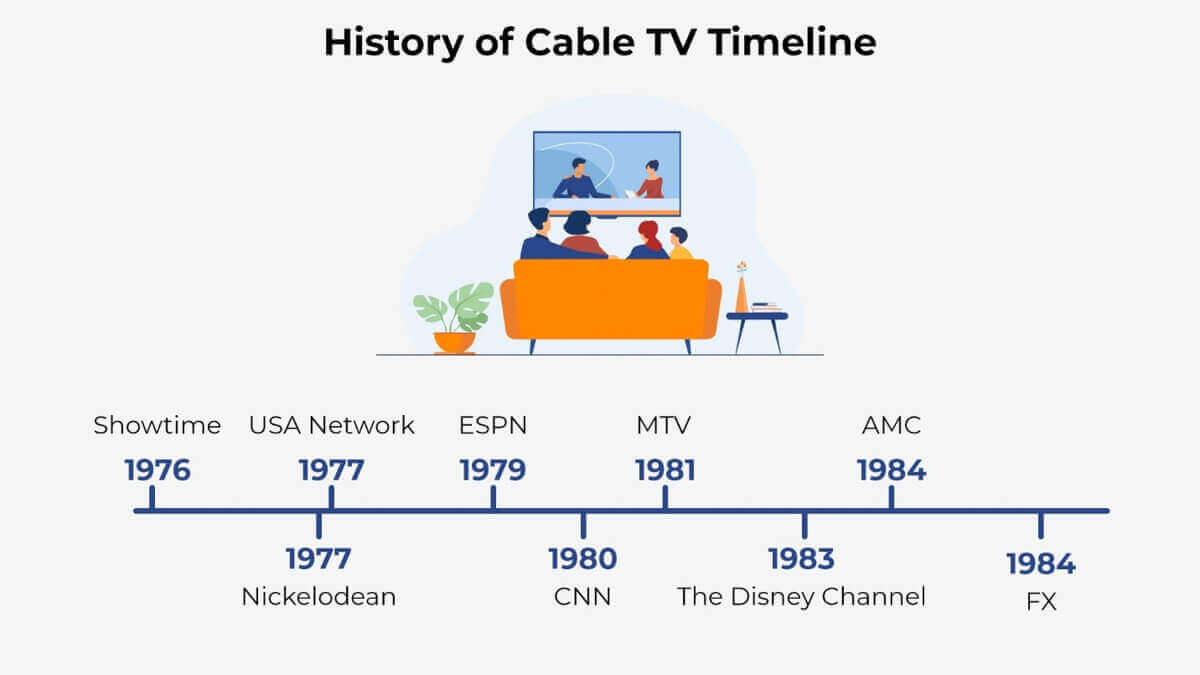
Many of these cable TV networks are still available today, and some of them, such as CNN, ESPN, and MTV, played instrumental roles in developing cable television. Few believed networks dedicated to one topic – news, sports, music, etc. – would be able to draw enough appeal to survive. But over time, these networks proved that they could stand on their own, and in doing so, launched a cultural revolution that is, in many ways, still playing out today.
It’s estimated that more than $15 billion was spent on building the cable infrastructure during this time, making it the largest private construction project in American history at that time; such an undertaking had not been seen in the United States since World War II.
Policymakers Slow Growth Again
The growth in demand, as well as the number of networks available, made cable TV a hot commodity. Cable companies responded by raising the price of their service, a logical decision when expanding profits is the ultimate motive. However, there was concern that cable companies’ pricing schemes were making it difficult, if not impossible, for people to access local channels, so Congress passed the Cable Television Consumer Protection Act of 1992.
This law forced cable companies to carry local broadcast stations and prohibited them from charging local cable providers. It also prevented cable companies from continuing to raise prices on consumers. Congress’ motivation was to prevent cable companies from gaining too much power in the market, which was hurting competition and creating a situation in which there were too few voices for people to listen to when trying to learn about the day’s issues and events.
Of course, while this law may have been good for society as a whole, it wasn’t great for the cable industry. Some argue that the growth experienced in the 1980s was partly due to people being charged more for the service, which exaggerated the growth numbers slightly.
However, despite these measures, cable did still grow throughout the 1990s. It had become an important part of American life, and accessing popular shows and movies often required a cable subscription. Throughout the 90s, more than 100 new stations emerged, and the average cable consumer could expect to have access to at least 50, which was far more than they could ever hope to get relying solely on over-the-air broadcasts.
Cable Gets Creative
By the beginning of the new millennium, cable was no longer just a necessity for those living in remote areas or a luxury for those who had the money. Instead, it had become a staple of American life. Shows such as The Sopranos and The Wire – both of which aired on HBO – had become national sensations.
However, as cable had become more popular, cable companies had to do more to compete with one another and ensure customer retention. As a result, things such as high-definition broadcasting, DVR service, on-demand programming, premium channels, interactive guides, and much more became new features and eventually standards.
All of this led to continued growth in the industry, which had more than 100 million subscribers. Many cable services began branching out into another area, broadband internet, as they could use their existing infrastructure to provide high-speed internet connections to people all around the country. Interestingly, this move may be what saves the cable industry, for things are changing quickly, and the future of cable TV has officially been called into question.
The End of Cable?
In 2007, a company called Netflix, which had up until that moment, made its money as a mail-order DVD rental service, launched its online streaming platform that allowed users to watch its content whenever and wherever they were, so long as they had an internet connection. At the time, no one was quite sure what impact this would have on the cable industry, but fast forward to 2020, and we can say that the impact was seismic.
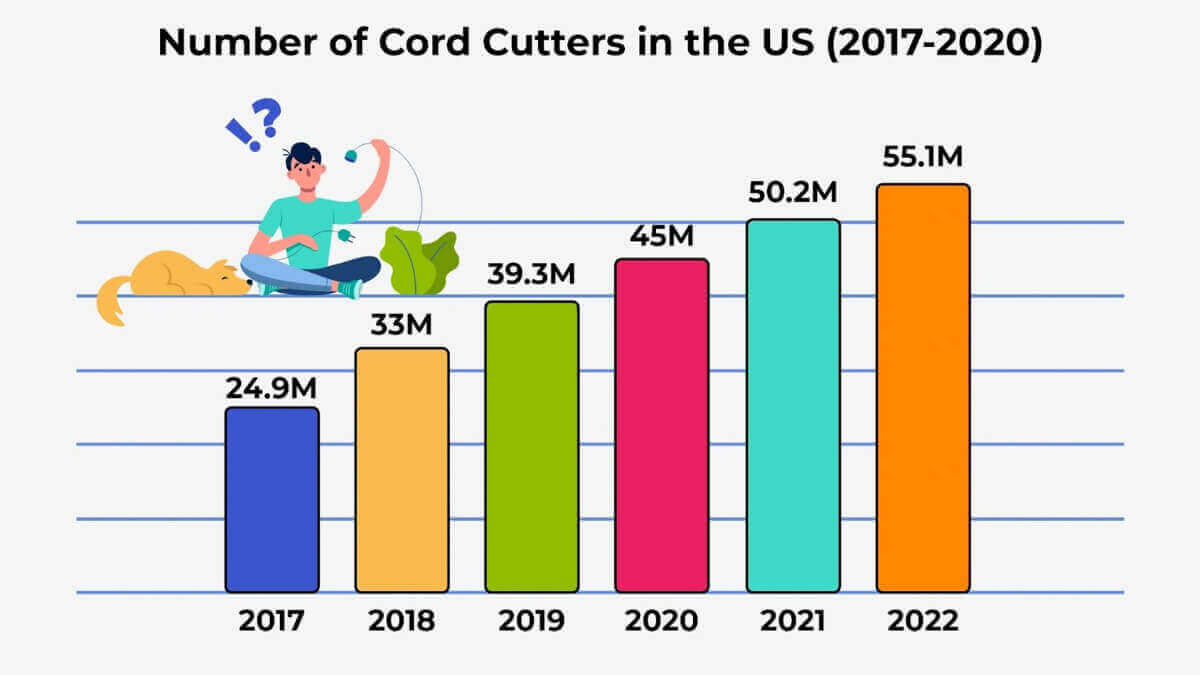
Netflix was first, but many other companies followed after, providing people with the first-ever alternative to cable service. Add in the rising cost of cable and the litany of exciting new original content being created by streaming platforms, and you have a recipe for disaster for cable companies.
In the past five years, there has been a growing trend known as “cord-cutting,” which refers to the decision many people make to ditch cable altogether and rely solely on streaming services. In fact, Statista reveals the majority of cord-cutters are between the ages of 18 to 34, who are mostly Millennials and Gen Z. This is happening at such an alarming rate that many have dubbed this moment to be the beginning of the end for the cable TV industry.
However, whether or not this will prove true remains to be seen. Many people still rely on cable, and the industry has managed to overcome adversity before. But even so, things do not look good. According to Pew Research, the number of adults in the U.S. who said they watched television via cable or satellite dropped 20 percentage points.
Conclusion
The history of cable television is an exciting story that starts with just a few towers being erected in remote parts of the country and moves to what we have today – widespread coverage and near-countless entertainment options. Yet despite being firmly entrenched in American life, cable TV appears to be at a crossroads. How it deals with this moment will play a pivotal role in determining how the rest of the industry’s history plays out.



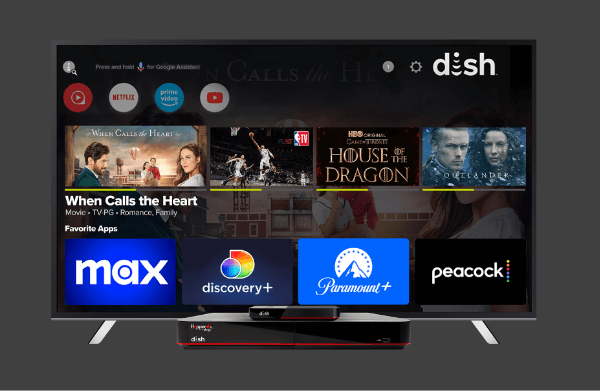
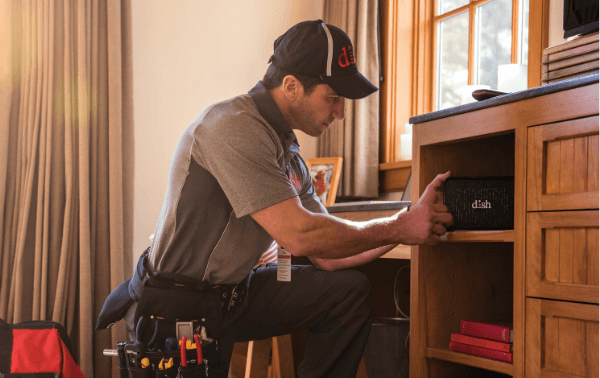

 Call
Call 

 Access Your Account
Access Your Account